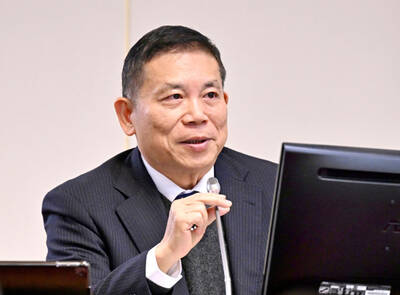Samsung Electronics Co’s operating profit rose more than 25 percent thanks to rising prices for semiconductors and surprisingly strong demand for its pricey foldable smartphones.
South Korea’s largest company reported operating profit of 15.8 trillion won (US$13.2 billion) in the three months ended last month, in line with the 15.75 trillion won average of analyst estimates. Sales were 73 trillion won, compared with estimates of 73.5 trillion, according to preliminary results released yesterday.
The world’s largest maker of memory chips and smartphones has benefited from strong demand as the global economy recovers from the COVID-19 pandemic. Chronic shortages have pushed up prices of memory chips, used in everything from mobile phones to smart cars, and the data centers powering cloud computing and services. Samsung is also expanding its foundry business, churning out custom chips for customers like Nvidia Corp.

Photo: AP
In the mobile business, Samsung is ramping up production to meet strong demand for its foldable phones. The Z series, launched in August, can cost more than US$1,800 but also includes the first sub-US$1,000 foldable in the Galaxy Z Flip 3, which has expanded the category’s customer base.
Samsung sold one million new foldable phones at home in Korea at the third-fastest sales pace after its Note 10 and Galaxy S8, the company said.
While Samsung is better known outside of South Korea for its smartphones, its profits are largely driven by its memory-chip business. Semiconductors account for the largest slice of its income.
Memory chip prices are expected to fall in the current quarter because of stockpiling by customers, signaling a potential cyclical downturn. Micron Technology Inc, one of Samsung’s primary rivals, gave a conservative outlook because PC demand is slowing.
“DRAM operating profit could climb due to sequential bit growth of 3-5 percent and also price rises in 3Q. NAND may also drive strong profit growth in 3Q due to a 10-15 percent sequential rise in bit shipments with a price increase of 5-9 percent. The chip shortage may help operating profit for the foundry business climb in 3Q. New foldable smartphones may fuel sales growth in the mobile division,” Bloomberg Intelligence said.
“While we expect DRAM market weakness in 4Q in 2021 and 1Q in 2022 on weak PC demand and relatively high inventory level at clients, we believe memory makers are more likely to accumulate inventory and revise down their 2022 capex to support memory pricing, rather than maximizing production,” Citigroup analyst Peter Lee said. “In any case, we expect the DRAM market to recover in 2022 due to supply constraint, given limited available clean room space and the launch of DDR5 products.”
Samsung’s foundry business has benefited from the transition to 5G wireless technology and high-performance computing, which have increased the global need for more sophisticated chips.
Robust sales of the Z foldable phones are likely to continue into the first quarter, and Chinese smartphone brands are increasing their purchases of foldable displays from Samsung, said Greg Roh, a senior vice president at HMC Securities.

Taiwan will prioritize the development of silicon photonics by taking advantage of its strength in the semiconductor industry to build another shield to protect the local economy, National Development Council (NDC) Minister Paul Liu (劉鏡清) said yesterday. Speaking at a meeting of the legislature’s Economics Committee, Liu said Taiwan already has the artificial intelligence (AI) industry as a shield, after the semiconductor industry, to safeguard the country, and is looking at new unique fields to build more economic shields. While Taiwan will further strengthen its existing shields, over the longer term, the country is determined to focus on such potential segments as

UNCERTAINTY: Innolux activated a stringent supply chain management mechanism, as it did during the COVID-19 pandemic, to ensure optimal inventory levels for customers Flat-panel display makers AUO Corp (友達) and Innolux Corp (群創) yesterday said that about 12 to 20 percent of their display business is at risk of potential US tariffs and that they would relocate production or shipment destinations to mitigate the levies’ effects. US tariffs would have a direct impact of US$200 million on AUO’s revenue, company chairman Paul Peng (彭雙浪) told reporters on the sidelines of the Touch Taiwan trade show in Taipei yesterday. That would make up about 12 percent of the company’s overall revenue. To cope with the tariff uncertainty, AUO plans to allocate its production to manufacturing facilities in

COLLABORATION: Given Taiwan’s key position in global supply chains, the US firm is discussing strategies with local partners and clients to deal with global uncertainties Advanced Micro Devices Inc (AMD) yesterday said it is meeting with local ecosystem partners, including Taiwan Semiconductor Manufacturing Co (TSMC, 台積電), to discuss strategies, including long-term manufacturing, to navigate uncertainties such as US tariffs, as Taiwan occupies an important position in global supply chains. AMD chief executive officer Lisa Su (蘇姿丰) told reporters that Taiwan is an important part of the chip designer’s ecosystem and she is discussing with partners and customers in Taiwan to forge strong collaborations on different areas during this critical period. AMD has just become the first artificial-intelligence (AI) server chip customer of TSMC to utilize its advanced

While China’s leaders use their economic and political might to fight US President Donald Trump’s trade war “to the end,” its army of social media soldiers are embarking on a more humorous campaign online. Trump’s tariff blitz has seen Washington and Beijing impose eye-watering duties on imports from the other, fanning a standoff between the economic superpowers that has sparked global recession fears and sent markets into a tailspin. Trump says his policy is a response to years of being “ripped off” by other countries and aims to bring manufacturing to the US, forcing companies to employ US workers. However, China’s online warriors